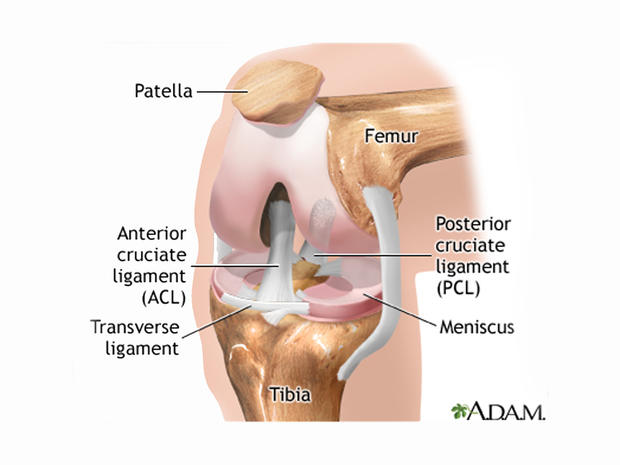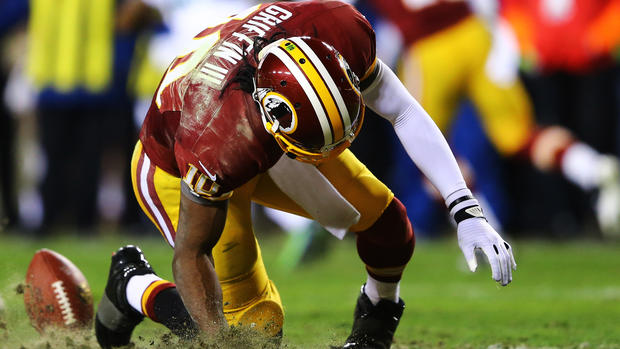Robert Griffin III undergoes knee surgery: What does procedure entail?
Robert Griffin III underwent surgery Wednesday morning to repair a torn ligament in his right knee and to assess the damage suffered when the Redskins rookie quarterback got injured during the Washington's playoff game against the Seattle Seahawks last Sunday.
CBSSports reports the 22-year-old underwent surgery to repair a torn lateral collateral ligament (LCL) in his right knee, where his surgeon, noted orthopedist Dr. James Andrews also reportedly found damage to Griffin's anterior cruciate ligament (ACL) in the same knee.
Everyone's been talking RG3's knee since the injury, considering he's one of the most electric players to come into the league in recent years. Dr. Leon Popovitz, co-founder New York Bone and Joint Specialists in New York City who is also an attending surgeon at Lenox Hill Hospital in New York City, helps explain the procedure to CBSNews.com
To get a better understanding of RG3's injury and surgery, an anatomy lesson is helpful.
The knee consists of structures called ligaments that are tissues that connect the upper leg bone (the femur) to the large lower leg bone (the tibia), which create the hinge joint that allows us to bend our legs. One vital ligament of the knee is the ACL, which sits centrally in the knee. That ligament, along with another thick ligament called the medial collateral ligament (MCL) -- which is also inside the knee - are crucial to a person's knee stability.
Then on the side of the knee resides the LCL (lateral means sides), which is a tissue that while much thinner than the others, still is important to knee strength and stability.
Popovitz explains when an ACL tears, an MCL often tears with it. But on more rare occurrences, he said, the torque and force of an injury can cause the LCL to tear, which appears to have been the case for RG3. What's more, because of the knee's anatomy, injuries to the ACL and LCL could also accompany damage to structures in the back of the knee, creating the potential for a major knee injury.
"Theoretically if he has torn both his LCL and ACL which often take with it the back structures, then he essentially has a created a knee dislocation, which can be a very serious and devastating injury," said Popovitz.
This could require a more complex surgery than a typical ACL ligament repair, he said. What's more, RG3 already tore his ACL in 2009 while he played at Baylor University, so this isn't a "virgin" ACL repair but a revision of a previous procedure.
According to Popovitz, who does not have special knowledge of RG3's case, this presents some challenges. Typical options for an ACL surgery include sewing up the ligament or seeking a new ligament from a cadaver or from another portion of the body. The cadaver option is not recommended for athletes because its not as strong a repair, said Popovitz, so it's likely the quarterback would seek a new ligament from his own body. RG3 reportedly already used a portion of the patellar tendon in his right knee for his previous ACL surgery, so he would need to get a tissue graft from his hamstring (which Popovitz would not recommend for athletes) or his other knee.
Sources told ESPN Dr. Andrews will use a patella graft from Griffin's left knee to repair the tear.
Since Griffin's ACL had already had been operated on, Popovitz said the procedure is more complicated because surgeons have to either widen the original hole in the femur bone where the original surgery took place, or re-position the hole to a new area, which makes things more difficult because they are working with only centimeters of space. And that's just for ACL surgery.
An LCL procedure is more complex than a first-time ACL repair, according to Popovitz, because the ligament resides near nerves and blood vessels that a surgeon has to worry about. Similar to the ACL, an LCL repair or reconstruction would consist of either sewing up the ligament, or harvesting tissue from another part of the body or a cadaver.
"Even though this is a very devastating injury and a complex injury to repair," opined Popovitz, "under the experience and skilled care of sports orthopedic surgeons like Dr. Andrews, he's still in the realm of possibility of returning to the NFL at a same high level. Unfortunately chances are smaller than a virgin ACL [injury].
The recovery for these surgeries can overlap, he said, so for the most, he would tell patients they could resume full activity after six to nine months.
Minnesota Vikings running back Adrian Peterson made an impressive return this season about eight months after tearing an ACL, even leading the league in rushing yards. But Popovitz, who previously served as a team surgeon for the U.S. Open Tennis Championships, said many people don't regain full strength or confidence in their knee that fast, and Peterson likely came back with such success because he was so motivated and hard working for his rehabilitation.
"I have a feeling RG3 is no different," he speculated. "I think there's a very strong likelihood he'd be back by next season."
Update: 5:00 P.M. EST -- Griffin's surgeon Dr. James Andrews said Wednesday afternoon that the quarterback "had a direct repair" of the lateral collateral ligament and "a re-do of his previous ACL reconstruction."
Andrews says he expects a full recovery because of Griffin's "high motivation."


